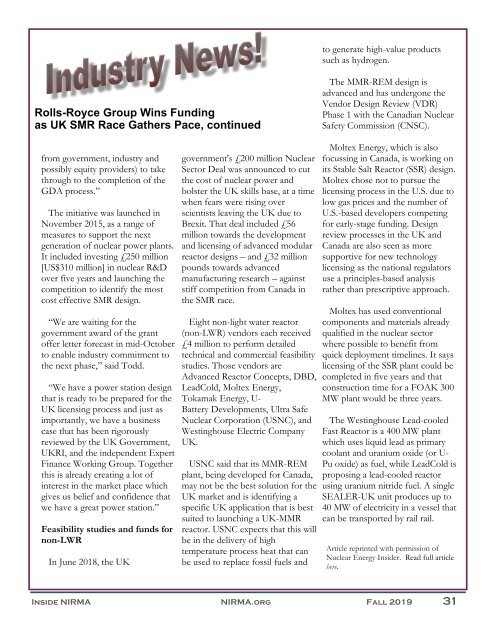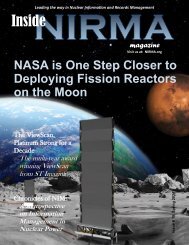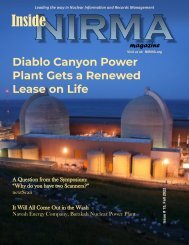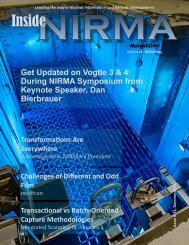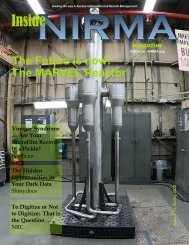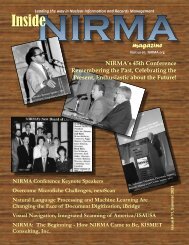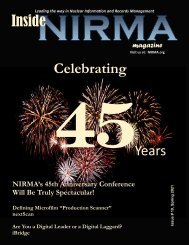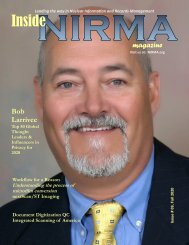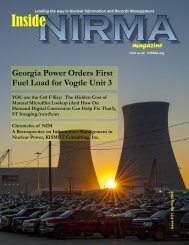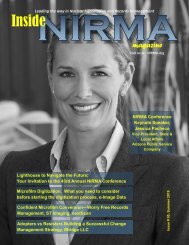Inside NIRMA Fall 2019 FINAL
Create successful ePaper yourself
Turn your PDF publications into a flip-book with our unique Google optimized e-Paper software.
to generate high-value products<br />
such as hydrogen.<br />
Rolls-Royce Group Wins Funding<br />
as UK SMR Race Gathers Pace, continued<br />
The MMR-REM design is<br />
advanced and has undergone the<br />
Vendor Design Review (VDR)<br />
Phase 1 with the Canadian Nuclear<br />
Safety Commission (CNSC).<br />
from government, industry and<br />
possibly equity providers) to take<br />
through to the completion of the<br />
GDA process.”<br />
The initiative was launched in<br />
November 2015, as a range of<br />
measures to support the next<br />
generation of nuclear power plants.<br />
It included investing £250 million<br />
[US$310 million] in nuclear R&D<br />
over five years and launching the<br />
competition to identify the most<br />
cost effective SMR design.<br />
“We are waiting for the<br />
government award of the grant<br />
offer letter forecast in mid-October<br />
to enable industry commitment to<br />
the next phase,” said Todd.<br />
“We have a power station design<br />
that is ready to be prepared for the<br />
UK licensing process and just as<br />
importantly, we have a business<br />
case that has been rigorously<br />
reviewed by the UK Government,<br />
UKRI, and the independent Expert<br />
Finance Working Group. Together<br />
this is already creating a lot of<br />
interest in the market place which<br />
gives us belief and confidence that<br />
we have a great power station.”<br />
Feasibility studies and funds for<br />
non-LWR<br />
In June 2018, the UK<br />
government's £200 million Nuclear<br />
Sector Deal was announced to cut<br />
the cost of nuclear power and<br />
bolster the UK skills base, at a time<br />
when fears were rising over<br />
scientists leaving the UK due to<br />
Brexit. That deal included £56<br />
million towards the development<br />
and licensing of advanced modular<br />
reactor designs – and £32 million<br />
pounds towards advanced<br />
manufacturing research – against<br />
stiff competition from Canada in<br />
the SMR race.<br />
Eight non-light water reactor<br />
(non-LWR) vendors each received<br />
£4 million to perform detailed<br />
technical and commercial feasibility<br />
studies. Those vendors are<br />
Advanced Reactor Concepts, DBD,<br />
LeadCold, Moltex Energy,<br />
Tokamak Energy, U-<br />
Battery Developments, Ultra Safe<br />
Nuclear Corporation (USNC), and<br />
Westinghouse Electric Company<br />
UK.<br />
USNC said that its MMR-REM<br />
plant, being developed for Canada,<br />
may not be the best solution for the<br />
UK market and is identifying a<br />
specific UK application that is best<br />
suited to launching a UK-MMR<br />
reactor. USNC expects that this will<br />
be in the delivery of high<br />
temperature process heat that can<br />
be used to replace fossil fuels and<br />
Moltex Energy, which is also<br />
focussing in Canada, is working on<br />
its Stable Salt Reactor (SSR) design.<br />
Moltex chose not to pursue the<br />
licensing process in the U.S. due to<br />
low gas prices and the number of<br />
U.S.-based developers competing<br />
for early-stage funding. Design<br />
review processes in the UK and<br />
Canada are also seen as more<br />
supportive for new technology<br />
licensing as the national regulators<br />
use a principles-based analysis<br />
rather than prescriptive approach.<br />
Moltex has used conventional<br />
components and materials already<br />
qualified in the nuclear sector<br />
where possible to benefit from<br />
quick deployment timelines. It says<br />
licensing of the SSR plant could be<br />
completed in five years and that<br />
construction time for a FOAK 300<br />
MW plant would be three years.<br />
The Westinghouse Lead-cooled<br />
Fast Reactor is a 400 MW plant<br />
which uses liquid lead as primary<br />
coolant and uranium oxide (or U-<br />
Pu oxide) as fuel, while LeadCold is<br />
proposing a lead-cooled reactor<br />
using uranium nitride fuel. A single<br />
SEALER-UK unit produces up to<br />
40 MW of electricity in a vessel that<br />
can be transported by rail rail.<br />
Article reprinted with permission of<br />
Nuclear Energy <strong>Inside</strong>r. Read full article<br />
here.<br />
<strong>Inside</strong> <strong>NIRMA</strong> <strong>NIRMA</strong>.org <strong>Fall</strong> <strong>2019</strong> 31


